Minnesota's Historic Fort Snelling, designed as a military outpost when built in the early part of the 19th century, was called into active duty one last time during World War II. For 300,000 young men of Minnesota's Greatest Generation, the fort represented their gateway into military service. At the end of the war, it represented their ticket out.
What was Fort Snelling during World War II?
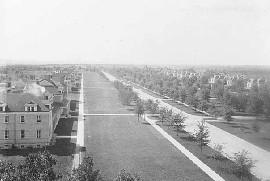
Physically it was a vast complex of offices, warehouses, rail yards, barracks, parade grounds and classrooms sprawled over a 1,500-acre site above the Minnesota and Mississippi Rivers. It was buildings as old as 120 years - solid brick and stone structures on park like green lawns studded with mature elms - and hundreds of tar paper and wood frame huts heated with coal stoves.
But more importantly, what was Fort Snelling to those who experienced it - over 600,000 men and women during the war years? To a regular army officer or enlisted man, the post's historical character made a strong impression. The commander of the Reception Center wrote in 1943:
"When I stood at the commandant's house overlooking the junction of the Minnesota and Mississippi rivers and gazed about me, I could hardly fail to realize that I was stationed at a post that was physically older than most of the other forts and posts in the Middle West. How far back in the nation's history this Fort Snelling reached! I could turn and see two buildings that actually dated from the 1820s - the Round Tower, the oldest man-made structure in Minnesota, and the Hexagonal Tower still guarding the actual junction of the two rivers, though its gun ports are laughable now when one considers the size of modern artillery.... Fort Snelling took its place in the vision of a coast-to-coast United States--a picture, incidentally, that few men were capable of envisioning in the year of our Lord 1820!…the men who were responsible for erecting Fort Snelling were not ordinary bureaucrats, but patriots who dared to love their country well enough to think and plan for its future."
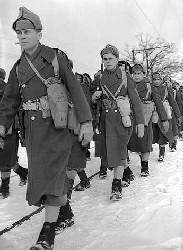
To a civilian living in the Twin Cities the fort may not have had such a romantic appeal. Rather it was a social institution and a vital part of the local community. For 3 generations the famous Third Infantry had called the fort home. Polo games attracted thousands, as did annual military shows. Summer training camps oriented hundreds of local young men to military service. And more recently thousands of GIs flooded the cities while hundreds of civilian volunteers staffed theaters, lounges and service centers both on and off post.
To a wide eyed, newly inducted draftee or young volunteer Fort Snelling was the first look at the army. It could be a cold impersonal place with shouting sergeants and overworked clerks, frigid barracks and painful shots, endless waiting in lines and that first taste of homesickness.
And to a Japanese American language student just released from the internment camp where his family would spend the rest of the war, Fort Snelling was more than long hours of study. For these men it was a valued place in a military that desperately needed their help, and it was social acceptance on post and in the local community.
Fort Snelling was all these things during World War II, but its preparation for service began years earlier.
December 7, 1941

By December 7, 1941, the post was a far different place than it had been ten years earlier. As Minnesota's only garrisoned post, Fort Snelling received substantial work projects under the Civilian Conservation Corps and later the Works Progress Administration. When President Roosevelt declared a national emergency in September 1939, work on post facilities was nearing completion, with extensive remodeling to existing buildings. It was in these years that many of the wooden trim features and ornate porches were removed from the late 19th century structures and replaced with functionally plain concrete. At a cost of nearly $2 million dollars, the riding stable was converted to a field house, the hospital complex expanded, new sports facilities and barracks constructed, utilities upgraded and quartermaster warehouses expanded. The old Round Tower was converted to a historical museum and on the far edge of the post, in a perhaps ominous development, the old post cemetery was converted to the Fort Snelling National Cemetery.
The Selective Service Act of 1940, intended to augment the armed forces and place them on a war footing, continued this expansion. The Fort Snelling Reception Station was organized in September as an outgrowth of the old Post Recruit and Casual Detachment. (Prior to this time individual units had recruited and trained new members.) Housed in the old World War I training camp, the Reception Station soon outgrew these quarters - and nearly froze out its recruits in the Armistice Day Blizzard of 1940. The non-insulated buildings of the so-called "Turkey Farm" gave way to a complex that would total over 300 structures by 1943. This part of the fort, so familiar to both new recruits and returning veterans of World War II, was located on what is now International Airport property, across Highway 5 from the Fort Snelling Officers' Club.
The old regular army units at the fort were also changing as war approached.The Third Infantry provided cadre for training new units, as it had trained citizen soldiers in the 1920s and 30s. Battery F of the 14th Field Artillery lost its superbly trained horses to a stable fire in 1939, and was reassigned as a mechanized unit. And the old 7th Tank Company, a part of the post since 1919, was redesignated as infantry and assigned to a new station.
Brief History of Fort Snelling
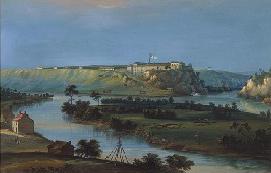
But before examining the war years in detail, let's take a look back to the beginning.The Minnesota Historical Society concentrates its interpretive effort on the Fort Snelling of the 1820s. Colonel Snelling's Fifth Infantry had just completed an impressive and enduring monument of stone and timber hundreds of miles beyond the fringe of the frontier. Their mission was to support the civilian operated United States Indian Agency in promoting and protecting the American fur trade, and to enforce a permanent peace in the region by control of the Dakota and Ojibwa peoples. As treaties - 1837, 1851 and others - moved the tribes off their lands and settlers flooded in, the need for a strong military garrison declined. The entire military reservation, encompassing most of Minneapolis, was sold in a land scam in 1858 and the fort closed. The Civil War reopened the post as a training ground for all of Minnesota's troops and coincidentally confirmed sale of the reservation - Franklin Steele traded all but 1500 acres for wartime rental of the post to the army. The post stagnated for a few years while the Civil War temporary and Colonel Snelling's now antiquated buildings deteriorated.
In 1878, the Department of Dakota changed all that. In the wake of the Custer massacre and continuing Indian troubles, Congress spent over $100,000 on Fort Snelling. Thirty new buildings were put up while most of the original fort was pulled down and its stones recycled. The post now served as headquarters and supply depot for a score of active smaller posts to the west. Construction continued to the Spanish American War then surged again in 1901 to 1905 when almost 2 million dollars went into the post. As early as 1895, post commander General Mason had called in vain for preservation:
"If the people of Minnesota would preserve Old Fort Snelling for coming generations, they should make haste; for sooner or later the buildings so dear to every Minnesotan will be torne down to make room for needed improvements. In the War Department, there is neither romance nor sympathy...a museum in the old fort, restored to its former state, would give us a place unique in its character. There would be nothing like it in the United States."
General Mason's call went unanswered for a full 70 years.
The coming of World War I taxed existing post facilities to the limit. The massive brick barracks became a training school for junior officers while the post hospital was designated US General Hospital Number 29 to treat wounded veterans needing rehabilitation. New recruits were housed in the Cantonment - a city of several hundred temporary structures west of the main post.
Between the two World Wars the cantonment was summer home to tens of thousands of students participating in Reserve Officer Training Corps programs and in Citizen Military Training Camps. The critical need for this training was increasingly apparent as war neared: by the late 1930s, 12 foreign powers had military establishments totaling from 1 to 6 million trained soldiers, compared to a U.S. regular army of 178,000 men.

Despite the slow move toward war, Fort Snelling was a pleasant post for a soldier during the 1920s and 1930s. The Old Guard - the Third United States Infantry - had called it home since 1888 when they replaced the African American 25th Infantry. The local community considered the Third Infantry as its own. Many local boys enlisted into and their sisters married into the Old Guard. With the largest military game preserve in the nation, a fine golf course, sports facilities, good quarters and easy duty, it was easy to understand why Fort Snelling was called "The Country Club of the Army." Citizens flocked to the post to watch polo games and the antics of the trick horse “Whiskey”. Each fall they were treated to the spectacle of recreated World War I battles.
All of this came to an abrupt end on December 7, 1941.
"You're in the Army now!"
The most common experience at Fort Snelling during the next 5 years was that of the "casual" - the recruit, the draftee or the returning veteran who was processed through Reception Station or Separation Point.
For a new recruit military service began with a physical examination, often indifferently done by a local doctor working under contract. After a couple of weeks to get his civilian affairs in order, the recruit would be on his way by bus or train to Fort Snelling. Early in the war a city band or members of the local American Legion post might send the recruit on his way. Later, as in previous wars, some of the novelty wore off.
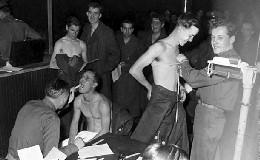
Arriving at the fort, recruits were marched to barracks and put to work with mop and broom. The over 200 recruit hutments were Spartan quarters made more unpleasant by impersonal noncommissioned officers who (like many behind-the-lines warriors) sometimes showed outright contempt for the new soldiers. A thorough army physical followed the next day, as did the all-important Army General Qualification Test. Scores on this test and results of the personal classification interview would determine the eager recruits future. Recruits, however, gave little effort to the test, often delivered before breakfast. Fort Snelling recruits still scored well above the army average (as we would of course expect of Minnesotans). This meant that a large number of recruits - 37% in 1943 - were assigned to the Air Corps. The practice of skimming the most intelligent recruits for air service was later criticized as it resulted in less intelligent and effective infantrymen.
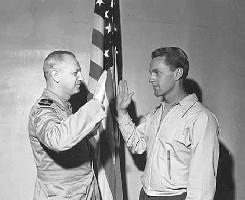
Following testing, our young recruit visited one of the clothing warehouses on post for as complete an issue of personal clothing and bedding as was on hand. In 1941 this sometimes meant left over WWI uniforms - supply became more regular shortly thereafter. The excitement of an army uniform faded in the next line as recruits were given their tetanus, smallpox and typhoid injections! After a personal interview with an army classification officer - questions on education, civilian jobs held, hobbies and skills - the new recruit was formally classified. Until this decision was made, he perhaps was drilled, certainly pulled KP and latrine orderly duty and he endured the required chaplain's lecture and orientation films.
When test scores and interview results had been compiled, the recruit's fate was sealed. He might be sent to an individual unit if his skills warranted. Those with high test scores likely were assigned to the Air Corps. The majority was designated for replacement training centers and eventual incorporation into existing units as replacements for casualties. Assigned to one of the ad hoc shipping companies at Fort Snelling, our now fully processed recruit awaited his transportation orders. The whole process could take from 3 days to as long as 2 weeks.
According to the commander of the Reception Station, Lieutenant Colonel Floyd Eller, careful classification and assignment were essential to the war effort: "Every effort must be made to provide each army organization with men that it can use, train and keep. The army must not be forced to undertake useless tasks, such as training clerks to be truck drivers in one place, and truck drivers to be clerks in another; rare experts must not be wasted; organizations must not be given ineffectives who are useless to them; and organization commanders must not be forced to sacrifice training because of initial paper work and administration incident to the reception of new enlisted men."
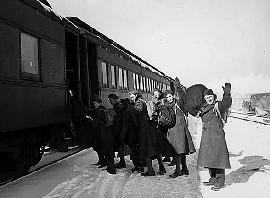
In all over 300,000 young men were here inducted into military service during the
war years. The Fort Snelling Reception Station grew to a peak in 1942 when its staff of over 1000 soldiers and civilians could fully process as many as 800 recruits each day. Later it would test officer candidates and send combat veterans home on furlough. One of the biggest problems at the fort was simply feeding and housing so many men. Fort Snelling was proud of serving meals to 3,200 soldiers in 75 minutes and of turning the post field house into an 850-bed dormitory on short notice. And in 1945 and 1946 the fort's efficiently operating Separation Point was the last taste of army life for tens of thousands of the men who helped win World War II.
What might our new recruit see if he were to walk around the post? Over on the lower post, in the area around the round tower and the chapel, Army units in training were housed. More barracks were on the upper post, along with the headquarters building with its clock tower and antique cannons on the lawn. Close by were the massive post hospital, fire and police stations, service club and movie theatre. Soldiers living in this area felt more fortunate than the recruits in their so called "dog houses" at the Reception Station. Across the wide parade grounds the quartermaster railroad yards received tons of supplies, clothing and food each week.
Linking the lower and upper posts with the Reception Center was the "Fort Snelling Dummy," an electric streetcar, run by Francis the Motorman. Off post, soldiers could easily ride on city streetcars to the many weekly dances and socials, or they might be lured to the nightlife in downtown Minneapolis or St. Paul. Back at the fort there were golf, swimming and shooting teams, singing groups and bands, plus libraries operated by the Red Cross. Many barracks had dayrooms with pool tables, pianos, and writing desks provided by service and church organizations. The air-conditioned post theatre was especially popular with such features as the latest Roy Rogers-Dale Evans movie or Popeye cartoons.
The Fort Snelling Bulletin, then the oldest post publication in the U.S. Army, each week carried army and local unit news, cartoons, and schedules of activities for the post. Every Sunday KSTP Radio broadcast its "This is the Army" series from the fort, going worldwide on Christmas 1944 with a concert by the fort's choir. "GI Joe", the musical produced by Fort Snelling soldiers, toured the state to raise funds for the Red Cross.
Let's look at a few views of life on the post before and during the war years.
New Military Units Created at Fort Snelling
Besides welcoming individual soldiers into the army, Fort Snelling also was the birthplace of new, specialized military units.
Railways were an integral part of the Twin Cities' economy in the 1940s, and it was logical that Fort Snelling should be used to train military railway soldiers. In May 1941, the Headquarters, Military Railway Service was created at the fort with a primary function to "oversee training of military railway troop units and to maintain relations with the commercial railroads under whose supervision the technical training of most of the units was being accomplished." Each major railway company was to sponsor at least one M.R.S. unit, of which 91 were planned.
Newly formed units did their technical training on the job, working side by side with civilian counterparts and learning skills from laying track to dispatching trains to repairing engines. Equally important was the study of foreign railroads systems and careful mapping of foreign lines. The M.R.S. saw important early service in North Africa, where its entire Headquarters was transferred in 1943. Railway battalions trained at Fort Snelling smoothly took over captured railroads and running stock and resumed rail supply operations only 2 days after the North African invasion.
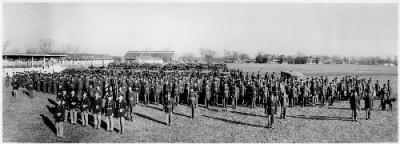
Several military police units also were created at Snelling. Those units designated as Zone of the Interior were responsible for guarding local airports, supply trains and munitions plants, and for transporting prisoners of war and Japanese American so-called "enemy aliens" to concentration camps in the Southwest. In September 1942 one of the MP battalions excelled in a surprise exercise, which saw them rushed in full combat gear to ordnance plants and strategic points around the Twin Cities. It was only later that they discovered that they had been covering a confidential visit of the President to the New Brighton Army Ammunition Plant. The efficiency of Fort Snelling MPs was increased by well-trained dogs, including a large poodle!
One of the most interesting units which passed through the fort was the 99th Infantry Battalion. Recruits for this organization were expected to have had some experience in snowshoeing and in skiing. More importantly, they were required to be conversant in Norwegian. From Fort Snelling the unit traveled to Colorado for mountain training, yet never spearheaded the planned invasion of Norway. Rather they fought as line infantrymen across Europe, reaching Norway only after the war and then to process Germans home.
A Wartime Secret: Military Intelligence Service Language School
Certainly the most unique - and the most secret part - of Fort Snelling's last war was the Military Intelligence Service Language School.
Activated at the Presidio of San Francisco in 1941, the school was mandated by the early discovery that most military age Japanese Americans had little knowledge of their parents' language. The student body of Nisei, primarily from the West Coast and Hawaii, moved to Camp Savage, Minnesota in May 1941 and occupied the site of the state home for indigent men. Minnesota provided an area with a high degree of racial tolerance well away from the strongly anti-Japanese West Coast. The program at Camp Savage grew rapidly to include: "reading, writing and speaking Japanese; translation, interpretation and interrogation; captured document analysis; Japanese military and technical terms; Japanese geography and map reading; radio monitoring; social, political, economic, and cultural background of Japan; cursive writing; and order of Battle of the Japanese army."
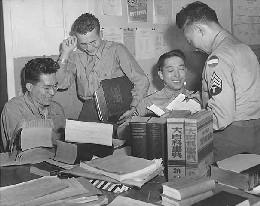
By 1944 the school had outgrown Camp Savage and was moved to Fort Snelling with its veil of secrecy finally removed. A decline in recruit processing after the 1943 full mobilization freed up barracks space and from then until the post closed, Fort Snelling assumed a distinctly Japanese-American flavor. The Post Bulletin records this change as Nisei names and news stories dominate each weekly issue. Students operated a short-wave radio tuned to Tokyo, and sent regular intelligence reports to Washington, and published an alumni newsletter for graduates in the field. The former post Sergeant Major reported that the language students were well disciplined and highly motivated soldiers, but that he had to field a few complaints from other soldiers' wives about the strange smells of Japanese cooking in the married quarters.
In 1945 Chinese and Korean language courses were added to the 6-month and 9-month curriculums. Of more interest was the activation of W.A.C. sections at Fort Snelling and their full assimilation into the school and post life. After the German surrender, emphasis shifted to spoken Japanese and class work was extended into evenings and weekends, recognizing the critical need for combat translators. After VJ Day, the school emphasis again shifted to civil affairs Japanese. Graduates of the school had served with every front-line unit in the Orient, and many of the last of the school's 6,000 graduates now played an integral part in moving Japan to democracy.
War's End: The Point of Separation
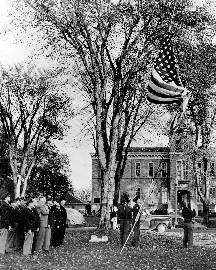
Fort Snelling's last war ended in 1946. The Separation Point - with its enviable record of out-processing veterans in 36 hours - was closed, and the Language School moved to Monterey, California.
Recruits for the occupation of Europe and Japan would be processed at new locations, like Fort McCoy, Wisconsin. Fort Snelling had little continuing utility to an army that needed posts able to handle 30,000 or more men for divisional and combined arms training. On October 15 the garrison flag in front of post headquarters was lowered for the last time, folded and presented to the wartime post commander Colonel Harry Kealey. Fort Snelling was fading into history.
The years since the war have seen the old World War II and earlier buildings of Fort Snelling used by a variety of agencies: The Veterans' Administration, Bureau of Mines, Department of Natural Resources, General Services Administration, US Army Reserve, and the Minnesota Historical Society. Most of the temporary structures are now gone, as are all of the old cantonment and recruit processing areas. In recent years much of the old artillery area, gun sheds and stables, have been razed for the new Minneapolis sports complex. The prognosis for those buildings that remain is poor. Perhaps adaptive uses can be found to retain portions of the World War II post into the future - but since abandonment of most of the headquarters and barracks area a decade ago, these have been few in coming.


